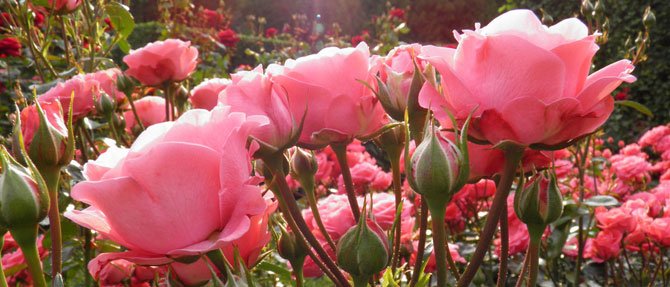Planting and Pruning Roses
Roses bring an old fashioned elegance and beauty to the garden. Their blooms vary in colour and scent and the many types of rose means there is one suited to every garden. Roses need some attention throughout the year to maintain their beauty and health. Here are our top tips for planting and pruning roses:
How to plant
-
 Roses prefer a soil which has good water holding capacity but is never waterlogged. A clay loam is ideal but roses will grow in most soils.
Roses prefer a soil which has good water holding capacity but is never waterlogged. A clay loam is ideal but roses will grow in most soils. - Improve light soils by digging in plenty of compost and prepare the ground by deep digging prior to planting.
- If drainage is a problem try raised beds (at least 30cm above ground level).
- Roses love lots of sun but they will be fine with some afternoon shade. Five hours of sunlight is adequate.
- Most roses won’t do well in a very windy position but they do need good ventilation. An overcrowded situation makes them more susceptible to disease.
- The best planting time for all rose varieties is from winter through to spring.
Pruning
While annual pruning for bush roses is essential to induce vigour and encourage free flowering, it is less crucial for climbers and ramblers as these tend to be so vigorous anyway.
Climbers: For the first two years, climbers should receive little pruning except to remove wayward shoots and to develop the desired framework of canes. The younger strong shoots are not shortened back but are attached to the support to fan out evenly. Side growths or laterals from these canes will bear flowers. These laterals can be cut back to within a couple of buds of the main canes when picking the flowers. Winter pruning of mature climbers consists of shortening laterals to 2-3 buds from their main base. Dead head regularly and occasionally remove an entire old stem and tie in a new shoot to replace it. Apply a winter clean-up spray immediately after pruning.
 Ramblers: These flower on previous seasons wood and should be pruned in February after they finish flowering. They produce several stems from their base each year. Cut back the stems that have borne flowers to ground level, leaving new stems to be tied in. New stems will have time to ripen before next summer when they will bear flowers.
Ramblers: These flower on previous seasons wood and should be pruned in February after they finish flowering. They produce several stems from their base each year. Cut back the stems that have borne flowers to ground level, leaving new stems to be tied in. New stems will have time to ripen before next summer when they will bear flowers.
In practice, taking down the old canes of very vigorous ramblers may not be possible. In this case, just cut back the lateral branches to about 75mm from the main stems. Ramblers cascading from trees or scrambling through shrubs in the wilder parts of the garden are probably best left to themselves once established.
Bush roses: Pruning cuts should be made at 45o angles, the upper point being approx. 5mm above the growth bud. Remove all weak, soft or small growths from the plants. Cut out old wood and wood that has died back. These two steps leave only well matured wood. Reduce its height. Do this by cutting off surplus growth about 5mm above an outward facing bud. The aim of this pruning is to keep the past season’s firm wood within the lower two thirds of the plant as a base from which spring flowers will arise.
Cuts to the bud union should be flush with it. Stubs that are left may die back into the union allowing disease to enter.

